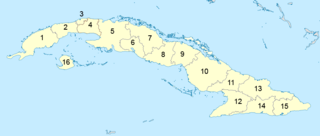
Administratively, Cuba is divided into 15 provinces and one special municipality. The current structure has been in place since August 2010, when the then-La Habana Province was divided into Artemisa Province and Mayabeque Province.

Villa Clara is one of the provinces of Cuba. It is located in the central region of the island bordering on the Atlantic Ocean to the north, Matanzas Province to the west, Sancti Spiritus Province to the east, and Cienfuegos Province to the South. Villa Clara shares with Cienfuegos and Sancti Spiritus on the south the Escambray Mountain Range. Its main cities are Santa Clara, Remedios, Sagua La Grande, Camajuani, Caibarién, Ranchuelo, Placetas, and Manicaragua.

Cruces is a municipality and town in Cienfuegos Province, Cuba. It is the home of the Mal Tiempo National Park which commemorates a battle in the 1895 War of Independence.

Rodas is a municipality and town in the Cienfuegos Province of Cuba. It was founded in 1859 under the name of Lechuzo. In 1879 it was renamed Rodas in honour of capitán general Caballero de Rodas.

Los Alcázares is a municipality and a coastal spa town and former fishing village on the western side of the Mar Menor in the autonomous community and province of Murcia, southeastern Spain.
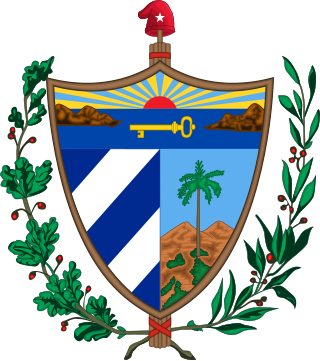
The provinces of Cuba are divided into 168 municipalities. They were defined by Cuban Law Number 1304 of July 3, 1976 and reformed in 2010 with the abrogation of the municipality of Varadero and the creation of two new provinces: Artemisa and Mayabeque in place of former La Habana Province.
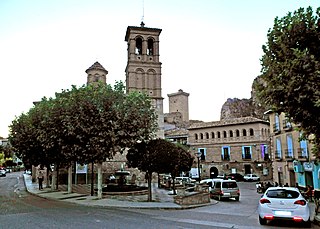
Alhama de Aragón is a spa town located in the province of Zaragoza, Aragon, Spain, situated on the river Jalón, a tributary of the Ebro. According to the 2004 census (INE), the municipality has a population of 1,150 inhabitants.

Cumanayagua is a municipality and town in the Cienfuegos Province of Cuba. It is located in a valley near the Guamuhaya Mountains (usually these mountains are referred as Escambray Mountains, 23 kilometres east of Cienfuegos, the provincial capital.

Palmira is a municipality and town in the Cienfuegos Province of Cuba. The whole municipality has 31,813 inhabitants.

Ranchuelo is a town and municipality in the Villa Clara Province of Cuba. It was founded in 1734 and has a municipal population of 50,708, of which about 15,000 in the town itself.
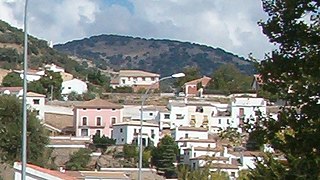
Frailes is a municipality in the Spanish province of Jaén, autonomous community of Andalucia, with a total area of 41,37 km2, a population of 1775 inhabitants and a population density of 43,41 inhab/ km2. It has been immortalised by the British writer, Michael Jacobs, in his 2003 book, The Factory of Light.

Santa Clara is the main railway station of the city of Santa Clara, seat of Villa Clara Province, Cuba. It is owned by the state company Ferrocarriles de Cuba (FFCC) and is located in front of Parque de los Mártires. It is one of the most important stations of Cuba and, along with Havana Central, Santiago and Camagüey, is a network's divisional headquarters.
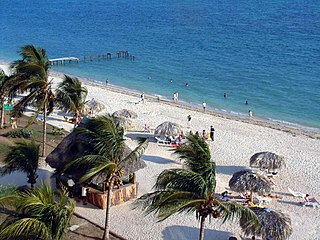
Casilda is a Cuban village and consejo popular of the municipality of Trinidad, Sancti Spíritus Province.

Esperanza, also known as La Esperanza, is a Cuban village and consejo popular of the municipality of Ranchuelo, in Villa Clara Province. It is the most populated municipal settlement after Ranchuelo.

Zulueta is a Cuban village and consejo popular of the municipality of Remedios, in Villa Clara Province. It is considered the Cuban birthplace of football and, with a population of ca. 10,000 is the most populated village in the municipality after Remedios.

Falla is a Cuban village and consejo popular of the municipality of Chambas, in Ciego de Ávila Province.

Ciego Montero is a Cuban brand of bottled water, part of Nestlé Waters, owned by the Cuban society Los Portales. Based in the village of Arriete-Ciego Montero, it produces the homonym water and soft drinks (refrescos) as the Gaseosa or the tuKola.
Ciego is a Spanish word meaning "blind". It may refer to:

San Diego de los Baños is a consejo popular and urban settlement in Los Palacios, Pinar del Río Province, Cuba.




















